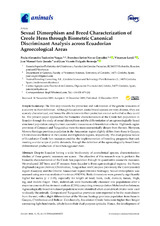Sexual Dimorphism and Breed Characterization of Creole Hens through Biometric Canonical Discriminant Analysis across Ecuadorian Agroecological Areas
Autor
Toalombo, Paula Alexandra
Navas González, Francisco Javier
Landi, Vincenzo
León Jurado, J.M.
Delgado-Bermejo, J.V.
Editor
MDPIFecha
2020Materia
Breed characterizationDual-purpose
Agroecological regions
Local products
Ecuador
Zoometry
METS:
Mostrar el registro METSPREMIS:
Mostrar el registro PREMISMetadatos
Mostrar el registro completo del ítemResumen
Despite Ecuador having a wide biodiversity of zootechnical species, characterization studies of these genetic resources are scarce. The objective of this research was to perform the biometric characterization of the Creole hen population through 14 quantitative zoometric measures. We evaluated 207 hens and 37 roosters from Ecuador’s three agro-ecological regions: the Sierra (highlands) region (Bolivar, Chimborazo, Tungurahua and Cotopaxi provinces); the Costa (coastal) region (Guayas); and the Oriente Amazonian region (Morona Santiago). Sexual dimorphism was assessed using one-way analysis of variance (ANOVA). Body dimensions were generally significantly higher for males (p < 0.05), especially for length of head, beak, neck, dorsum, tarsus, thigh, leg, and middle finger. Then, individuals were biometrically clustered into populations after a stepwise canonical discriminant analysis (CDA) computing interpopulation Mahalanobis distances. Agroecologically-based structured populations were identified when zoometrical criteria were used to classify the animals. Cotopaxi and Tungurahua provinces were reported to be the most distant from the rest, with a slight differentiation of the Morona Santiago province population from those in Guayas, Chimborazo and Bolívar. Conclusively, Ecuadorian Creole hens were higher than longer contrasting light hen breeds, which favors their dual-purpose aptitude. Hence, the development of selection programs aimed at Ecuadorian differentiated entity of production of eggs and meat across agro-ecological areas is feasible.

